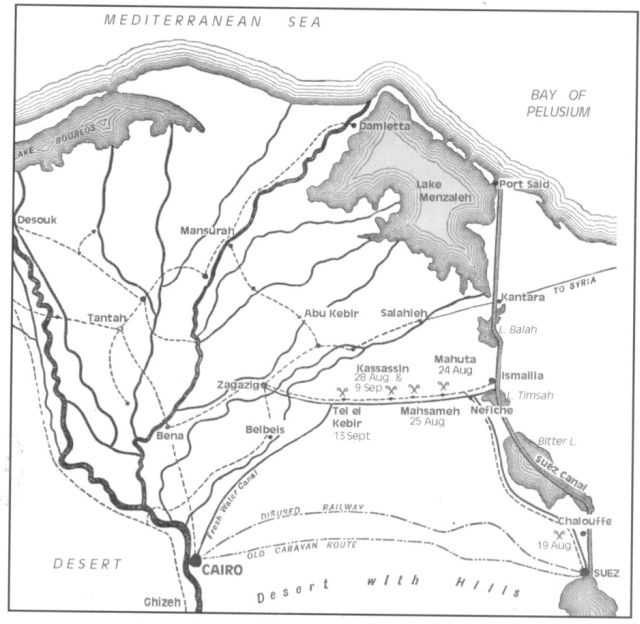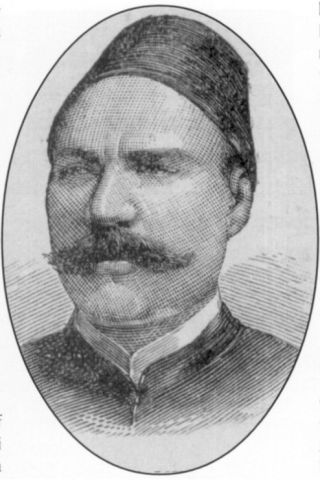

 The South African
The South African
by Dr Angelo Nicolaides

Map showing the sites of Tel-el-Kebir and other actions in the Egyptian Campaign of 1882.
(Adapted from a map in J Grant, British Battles on land and Sea, 1897).
Under Muhammad Ali's grandson, Khedive (king) Ismail, Egypt's economy had prospered. This was predominantly the result of exporting cotton to Britain, whose usual supplier, the America States, were involved in war from 1861 to 1865. On the back of the economic upswing, Ismail modernised his army and poured vast sums of borrowed money into upgrading and extending the reach of the Egyptian railway lines into the Sudan. The cotton boom fizzled out in 1868 as the USA resumed supplies. Ismail became increasingly indebted to Britain and France as the Suez Canal opened in 1869. European shipping dominated Egypt's export and import trade. To make matters worse, it became clear that Ismail's innovations were beyond Egypt's resources.
By 1876, Ismail was obliged to announce that Egypt was virtually insolvent and would not be able to service its foreign debts. These totalled a staggering £90 million! Britain and France needed to protect their huge financial interests in Egypt and Ismail was forcibly deposed. He was succeeded by his son, Tewfik, who, like his father, was nominally a vassal of the Turkish Sultan in Constantinople. Egypt's finances fell under the 'dual control' of Britain and France. But it was Disraeli who managed to secure a direct influence in the administration of the Suez Canal Company for Britain by obtaining most of the shares on offer. An Egyptian colonel, Arabi Pasha, led a nationalist movement which was determined to expel Europeans and Turks from Egypt. Tewfik's position grew steadily weaker as Arabi Pasha's supporters became more and more aggressive. An insurrection resulted under the banner 'Egypt for Egyptians'. France was reluctant to be drawn into any potential conflict, so it was left to Britain to deal with the situation alone. Britain was also unsuccessful in her attempts to draw Turkey into supporting her against Arabi Pasha, who had established himself as virtual dictator in Egypt (Featherstone, pp17-20).
In May 1882 a joint Anglo-French fleet was sent to Alexandria under Admiral Sir Beauchamp Seymour. The fleet was unsuccessful in preventing the massacre of fifty Christians in Alexandria. Arabi Pasha began to fortify Alexandria with 150 heavy guns and trenches carefully positioned to defend the harbour against European attack.
Although the French prime minister, Charles de Freycinet, agreed to the stationing of an Anglo-French force in the Canal Zone, the French Government did not agree to be involved in risky foreign adventures. Consequently, the French fleet was withdrawn from Alexandria as well. The British fleet, however, began a ten-hour bombardment of the port on 10 July 1882. This was deemed necessary by Admiral Seymour after a British ultimatum, calling for the removal of Arabi Pasha's heavy guns, was rejected (Maurice, p 47). The Egyptian positions mounted numerous 12- and 18-ton guns. There were also eleven gunboats armed with 64-pounder and 7-inch rifled guns.

Arabi Pasha
(Source: J Grant, British Battles on land and Sea, Cassel & Co, London, 1897)
The Egyptian gun batteries soon crumbled. Despite the exceptional bravery of the Egyptians, they were doomed by the inefficient leadership of inexperienced officers. Only ten Britons were killed in the naval bombardment, which accounted for about 900 Egyptians. The British spiked the remaining guns that had not been destroyed by the shelling. Following two days of arson and rioting in Alexandria, British military patrols were landed. These were forced to resort to house searches for enemy forces.
However, Arabi Pasha's resolve to resist intensified. His army, which was made up of various Arab tribes, blacks from the Sudan, and Bedouin, rapidly grew in size. Gladstone, now Britain's prime minister, opted to increase his country's involvement without delay: 'We should not discharge our duty if we did not endeavour to convert the present interior state of Egypt from anarchy and conflict to peace and order.' (Gifford & Louis, pp 114-15).
Britain's leading soldier, Sir Garnet Wolseley, was sent to crush Arabi Pasha with a force of 40 000 men collected from British garrisons in Cyprus, Malta, Gibraltar, and even as far away as India. Arabi Pasha assumed that the British force would attack his positions at Karfdowar after Wolseley had landed a mock force there. But the main force landed at Ismailia, about half way along the Suez Canal, on 20 August 1882. Wolseley sent General Graham and a force of 200 men to Kassassin in the desert. Their objective was to secure the Sweetwater Canal before enemy forces were able to take it.
The forces of Arabi Pasha, numbering about 60 000 men, were split into three main areas of operation. The main force was located at Tel-el-Kebir, on the railway between Cairo and Ismailia, while the balance was divided equally between Cairo and the port of Alexandria. Wolseley's main consideration was that Islamic fanaticism could take root if Arabi Pasha's activities were not stopped immediately. That would have placed British interests, and her strategic advantage, in grave peril (Pakenham, p 136). Fanaticism, if unchecked, could stir up tens of thousands more Egyptian males to serve Arabi Pasha against the alien overlords. Despite the conscription of males into the Egyptian military system, there were probably only 12 000 regular soldiers at Tel-el-Kebir. These were armed with Remington 11 mm (.433-inch) rolling-block rifles imported from the United States. They were also armed with a sword-type bayonet. The conscripts had old muzzle-loading muskets and wavy-bladed sword-type bayonets. They numbered some 6 000 men, and were supported by a cavalry regiment. The greatest problem facing Arabi Pasha's force at Tel-el-Kebir, and indeed elsewhere, was the inefficiency of his officers.
However, the Egyptians' construction of entrenched positions helped make up for the inefficiency of the officer corps. Furthermore, the Krupp artillery at Arabi's disposal, despite being ten years old, was of a high standard. There was clearly a great reluctance on the part of Arabi to face British forces in open battle. Despite having thousands of conscripts, much of Arabi's force was made up of older men who had served in Abyssinia and the Sudan, and younger recruits with no military experience. General Sir Gerald Graham and his 2 000-strong force easily overcame a measure of resistance at Mahuta, and subsequently dug in at Kassassin. The Egyptian forces attacked across the canal on a number of occasions, but were bombed into rapid retreat on each occasion by concentrated fire from the Royal Marine Artillery. The Egyptians dug a line of trenches some 900m away from the British position, while some of their infantry advanced along the canal under the support of Egyptian artillery fire.
At dusk, Graham counter-attacked with a cavalry force comprising three squadrons of Household Cavalry and the 7th Dragoon Guards. The Egyptian infantry was in total disarray as the cavalry cut straight through their lines and. forced them to retreat. Arabi Pasha took refuge at the rear of the entrenched Egyptian position at Tel-el-Kebir. For the next two weeks, there followed a series of minor skirmishes between British and Egyptian cavalry units, but no major engagement. Arabi's lines at Tel-el-Kebir were manned by about 22 000 men with artillery support. They extended for roughly 7km.
Wolseley began his advance from Ismailia on 12 September and proceeded to Arabi's position at Tel-el-Kebir, which was approximately 110km from Cairo (Wolseley Papers Sussex WP, 11/17i/2 Wolseley to Lady Wolseley, Sept 1882). If Arabi could be crushed in a single battle, Britain would be feared, and all hostilities would cease forthwith. Wolseley expressed his feelings in a letter to his wife: 'I do so long for a complete victory that may make the world feel that England has yet something left in her, and that her soldiers have still strength and courage.'(McCalmont, pp 218-19).
Tel-el-Kebir was to be attacked at first light so that the element of surprise could aid the British operation, and so that the British forces would be unobtrusive under cover of darkness until the final assault on Arabi's ramparts. The 17 000-strong British force, with its 67 artillery pieces, would begin the operation at 00.15 on 13 September. They were to advance at a rate of 2km/h until they reached their target at roughly 05.00.
The attack would begin before 05.45, when Arabi's patrols set out into the desert (Temperley & Penson, pp 85-9). Each British soldier was issued with 100 rounds of ammunition, and a Martini-Henry rifle and bayonet. The advance was made over a 7km front. Two divisions, consisting of two infantry brigades each, attacked Arabi's positions. The divisions were separated by the British artillery in the centre and a cavalry force on the far right flank. A Naval Brigade and an Indian Brigade were to advance along the wadi in which lay the canal and the Cairo-Suez railway.
The advance, led by the Highland Brigade on the left flank, was obliged to halt for an hour after two other flank battalions, one far left and one right, lost direction and were marching towards each other some 6km apart. Once the mess was sorted out, the advance resumed. When the Highland Brigade was 400m from the line of ramparts, they were met by a volley of fire from the Egyptian riffles. The British buglers sounded the attack and the infantry stormed the ramparts with bayonets fixed.
Wolseley lost roughly 200 men in the initial assault on the Egyptian positions. The British force had to cross a two metre wide, two metre deep ditch before scaling the 3,5m entrenched positions. The Highland Brigade, bagpipes blaring, shattered the enemy on the left flank while the Irish regiments attacked the centre. The Naval Brigade and the Indian Brigade met very little resistance as they forced Arabi's right flank to retreat. Arabi's forces had been routed without the full force of Wolseley's attack coming into play at all.
Arabi's forces were in total disarray. They deserted their positions and fled into the desert in their hundreds. Arabi had been amongst the first to flee. His camp was destroyed and his guns and stores captured (Pribram, pp 112-15). Wolseley's forces suffered 339 casualties while estimates of casualties among Arabi's men ran into thousands. However, their tactics showed immense bravery as they continually regrouped to go on fighting after each successive position was lost. The British cavalry proved to be the factor that turned the tide because it was they who finally dispersed Arabi's forces.
The day after the battle, the British cavalry entered Cairo and Arabi was captured. This ended the campaign by the British forces. Any hint of revolution immediately dissipated (Wood, p 317). Tewfik was once again leader of Egypt, after the British exchequer had paid out £2,3 million. The speed of the campaign bore testimony to the excellence of Wolseley's military prowess.
Since the British occupation was not due to a preconceived plan, Britain was not sure what she should do with Egypt once victory was achieved. Gladstone, and subsequent British prime ministers, found it increasingly difficult to leave Egypt. The country was strategically situated in the eastern Mediterranean. It guarded the Suez Canal and the main gateway to India, southern and eastern Asia, and Australia.
Bibliography
Featherstone, D, Colonial Small Wars Tel-el-Kabir.
Gifford, P, and Roger Louis, W M, France and Britain in Africa.
Maurice, J F, Military History of the Campaigns of 1882 in Egypt.
McCalmont, H, The Memoirs of Major General Sir Hugh McCalmont.
Pakenham, T, The Scramble for Africa
Pribram, A F, England and the International Policy of the Great Powers 1871-1914.
Temperley, H and Penson, L M, Foundations of British Foreign Policy 1792-1902.
Wolseley Papers Sussex WP, 11/17i!2 Wolseley to Lady Wolseley (Sept 1882).
Wood, A, Nineteenth Century Britain 1815-1914.
Return to Journal Index OR Society's Home page
South African Military History Society / scribe@samilitaryhistory.org